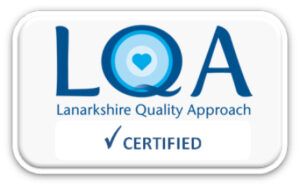Treating Cow’s Milk Protein Allergy
Information for patients
NHS Lanarkshire Dietetic Department
PIL.COWMPA.17074.L
Information for parents
To be used alongside general weaning advice from health visitor. The only difference is avoidance of all foods containing cows milk.
Your infant/child may have a cow’s milk protein allergy. Some infants and children are allergic to cow’s milk protein. Overtime, many outgrow this allergy. It can take many months to years for this to happen.
Trial of a milk free diet is the best way to diagnose a cows milk allergy as there are no reliable tests under the age of 1yr.
This booklet provides information for breast fed and formula fed children with cows milk allergy.
Milk allergy usually causes multiple symptoms and gut symptoms are usually present. Symptoms can occur within minutes or up to several days after exposure to milk.
Possible symptoms of cow’s milk allergy include:
- Diarrhoea or constipation
- Vomiting/reflux
- Excess wind/colic/bloating
- Food refusal
- Blood/mucus in stools in well infant
- Faltering growth
- Eczema
- Redness/rash
- Hives
- Swelling of lips, eyes, tongue
- Itch
- Runny nose
As there are no reliable tests under the age of 1yr to diagnose a cow’s milk allergy (Please discuss this with your GP or consultant if the reaction is severe and occurs immediately after consuming cows milk protein before undertaking), a trial of a milk free diet is currently recommended.
This involves removing milk from the Mum’s diet if breastfeeding, or the infant’s diet, for 2-4 weeks to see if symptoms resolve. If symptoms are partly or fully resolved milk will be reintroduced in most cases to confirm the allergy. If symptoms recur, the infant must remain milk free for at least 6 months after this.
Breastfed baby
Foods that contain cow’s milk protein should be excluded from mum’s diet for two to four weeks.
In order to meet breastfeeding requirements of calcium (1250mg) and Vitamin D (10mcg), daily supplements and fortified alternative dairy products will be needed.
To confirm the allergy, you may be asked to retry cow’s milk within your diet, depending on your baby’s initial symptoms.
If a cow’s milk allergy is confirmed (by return of symptoms), you should follow a milk free diet whilst you continue to breastfeed. Your baby will need to be weaned following a milk free diet.
If your baby’s allergy became apparent when you were solely breastfeeding and you want to introduce formula, this will usually be an extensively hydrolysed formula. However an amino acid formula will be used in severe allergy and severe atopic eczema.
The prescription from your GP is then taken to your pharmacy for the specialist formula to be provided.
Formula fed baby
A GP prescription will be arranged for the most suitable formula, depending on your baby’s symptoms. This could be:
- Extensively hydrolysed formula – the cow’s milk protein is broken down into small pieces which is easier for your baby to manage
or
- Amino Acid formula – the protein is completely broken down.
Your specialist formula can be used in weaning foods.
These specialist formulas may change the colour of your baby’s poo, this is normal.
After 2-4 weeks on a milk free diet, you will usually need to re-challenge by reintroducing cow’s milk in mum’s diet or reintroducing a standard infant formula to confirm the allergy. More information is found in Milk Re-challenge Information which will be provided.
Changing formula
Gradually change over to your new formula to ensure your baby accepts the new taste. For example in each of your baby’s bottles: Replace 1 scoop/1oz. of the normal formula with the prescribed formula.
E.g. in a 6oz. (180mls) bottle:
Add 180mls of boiled water to the bottle allow to cool to room temperature then put in 1 scoop prescribed formula and 5 scoops standard formula.
Increase the amount of prescribed formula and reduce the amount of normal formula by 1 scoop/1 oz. per day, until the whole bottle is prescribed formula.
Prescription milk
These specialist formulas are provided on prescription by your GP. The prescription is then taken to your pharmacy for the formula to be provided. Make sure you reorder when you only have a weeks supply left.
Be aware
You should avoid goat and sheep milk products as the proteins are similar to those in cow’s milk products.
Cows milk allergy is not the same as lactose intolerance. Lactose free formulas/products still contain milk protein. These should be avoided.
Organic products do not contain added calcium as there is currently no organic source of calcium available. These should be avoided.
Soya formulas should not be used for babies under six months old. They can be used after this time but some babies may react to soya in the same way as they react to cow’s milk, therefore they should be introduced with caution.
There is no need to change to a suitable follow-on formula at six months if the child is offered a varied weaning diet.
Weaning
Individual manufacturers have lists of their own brand products which are free from milk.
You should always check the labels of any product no matter how often you use them, to see if the product contain cows milk.
The following ingredients contain cow’s milk
- Butter, butter oil, buttermilk
- Casein (Curd) , hydrolysed casein, caseinates, sodium caseinate, calcium caseinate
- Cheese
- Cows milk (fresh, UHT, evaporated, condensed, dried)
- Cream/artificial cream
- Margarine, Ghee
- Lactoglobulin
- Lactoalbumin
- Lactose
- Milk solids, non-fat milk solids
- Whey, whey solids, hydrolysed whey, whey powder, whey syrup sweetener, whey protein
- Yoghurt, fromage frais
- Ice cream
- Milk powder, skimmed milk powder, milk protein, milk sugar
- Modified milk
- Milk puddings
Cow’s milk alternatives
The following can be used within foods after six months of age, and may be used as a main drink after your child’s first birthday… if they are growing well. Your specialist formula can be prescribed until 2 years if your child is settled on this.
Milks: soya, oat, coconut, almond, hazelnut, cashew, pea milk, hemp, quinoa.
Ensure this contains added calcium
Rice milk should not be used as a main drink until four and a half years of age.
Cows milk product alternatives
Soya and coconut based yoghurt, cheese, spread and milky puddings are available and should be offered as dairy replacements from 6 months of age. Proceed with caution when introducing soya products as some babies may react to soya in the same way as they react to cow’s milk.
Foods naturally free from milk
- Fruit
- Vegetables
- Plain Meat, chicken, fish, lentils
- Rice
- Potato/sweet potato
Recipes:
Baby Rice
- 1 tablespoon of baby rice
- 3 tablespoons of specialist formula/milk substitute warmed
- Fruit of choice
For example: stewed apples or berries
Method:
- Add all the rice and milk/specialist formula into a bowl and stir
- Mix with puréed, mashed or stewed fruit
Baby Porridge
Ingredients:
- 3 tablespoons of oats
- 150ml of specialist formula/milk substitute
- Fruit of choice
For example: 1 small banana mashed
Method:
- Add all the ingredients into a small pan, cover and bring to the boil
- Reduce the heat and allow to simmer for 5 minutes, stirring occasionally
- More milk/specialist formula can be added if a thinner consistency is needed
Milk-free custard (2 servings)
Ingredients:
- 2 rounded teaspoons of custard powder
- Choose original powder tub and check label to ensure milk is not an ingredient
- 200ml of specialist formula/milk substitute
Method:
- Mix the custard powder with a small amount of specialist formula/milk substitute in a bowl into a smooth paste
- Add the remaining specialist formula/milk substitute
- Pour into a small pan and stir over a medium heat until the custard thickens, remove from heat as the custard comes to the boil
- Serve with mashed/stewed soft fruit
White sauce
Ingredients:
- 2 rounded teaspoons of cornflour
- 300ml(1/2 pint) milk substitute
Method:
Place all ingredients in a pan and heat gently, whisking continuously until the sauce thickens.
Good sources of calcium
Once your child is eating a variety of foods. It is important that they obtain enough calcium. Routinely this would come from breast milk/specialist formula/milk substitute
- Calcium enriched milk alternatives
- e.g. soya/almond/coconut/oat/pea/cashew/hazelnut
- Calcium fortified soya/coconut/oat yoghurt
- Milk free custard made from powder /rice pudding
- Fortified cereals and Breads (often those with white and wholmeal flour mix)
- Tofu (If set with calcium chloride (e509) or calcium sulphate (E516))
- Almond nut butter
- Sesame paste
- White flour based products E.g. white bread, pittas, wraps,
- Mashed Beans
- Lentils for example in soups and curries
- Green vegetables such as broccoli,
- Minced or flaked fish, for example salmon
For further suggestions see the BDA website.
Vitamin D
Throughout life, vitamin D is essential for keeping bones healthy. In Scotland, we only get enough sunlight to make vitamin D during the summer months (April to September). It is now recommended that everyone in the UK should take a vitamin D supplement daily, particularly during the winter months (October – March).
As a precaution, breastfed babies from birth should also be given a supplement of 10µg vitamin D per day. Babies who are formula fed do not require a vitamin D supplement if they are having at least 500ml/day, as infant formula already has added vitamin D.
Meal plan:
| First Foods Around 6 months |
Around 7 months | 9-12 months | |
| Texture | Mashed, cooked, soft foods with a smooth consistency | Move onto thicker, lumpier foods. Along with soft finger foods to encourage chewing | Move on to chopped up with more finger foods |
| Types of food | Start with fruit and vegetables then add in starchy foods, soft meat/fish, lentils, beans and nut butters | Try to get into a regular meal pattern, aiming for: -2-3 servings of starchy foods -2 servings of fruit and vegetables -1 servings of meat, fish, eggs, lentils or beans |
Now aim for a daily meal pattern containing: -3-4 servings of starchy foods -3-4 servings of fruit and vegetables -2 servings of meat, fish, eggs, lentils or beans |
| On waking | Breast milk or milk substitute | Breast milk or milk substitute | Breast milk or milk substitute |
| Breakfast | Baby rice/porridge (with milk substitute) and mashed fruit | Porridge/mashed wheat biscuit (with milk substitute) and mashed fruit | Porridge/mashed wheat biscuit (with milk substitute) and mashed fruit |
| Lunch | Mashed vegetables with soft meat/lentils | Mashed potato and vegetables with soft flaked meat, lentils or beans | Sot cooked potato, pasta or rice and vegetables with soft flaked meat, lentils or beans |
| Dinner | Stewed soft fruit with milk free custard/milk free yoghurt | Stewed soft fruit with milk free custard/milk free yoghurt | Stewed soft fruit with milk free custard/milk free yoghurt |
| Bedtime | Breast milk or milk substitute | Breast milk or milk substitute | Breast milk or milk substitute |
Useful websites:
To find out more about weaning please see weaning videos on the NHS Lanarkshire website.
Useful apps:
- Foodmaestro
- Allergymenu
Pub. date: July 2021
Review date: July 2023
Issue No: 05
Reference: PIL.COWMPA.17074.L
21_14157
If you need this information in another language or format, please e-mail:





